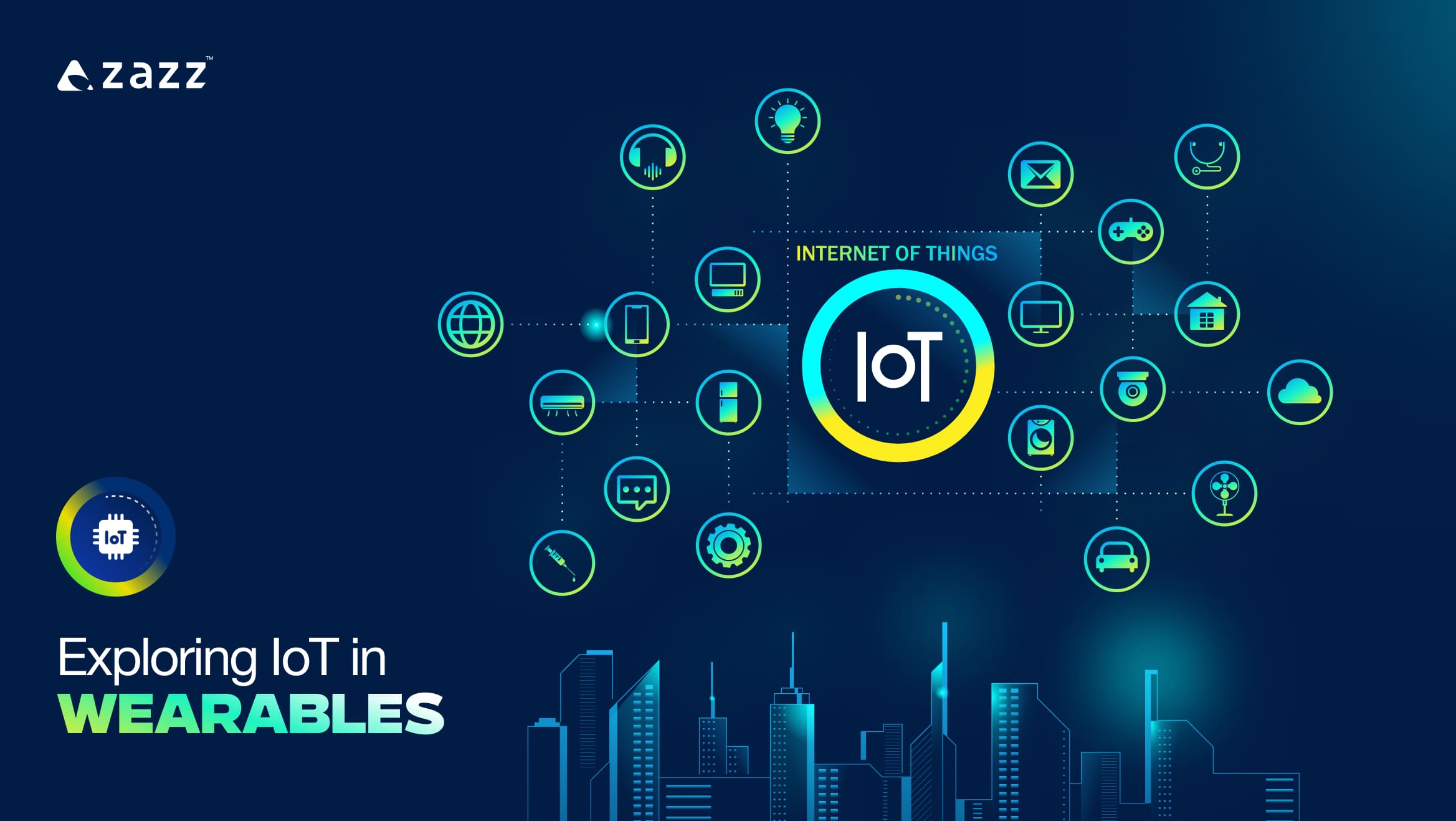
Wearable technology is integrating the IoT development more deeply into our daily lives, making routine tasks more convenient and monitoring health metrics more accessible. Devices like fitness bands and smartwatches allow users to track physical activities and vital signs without interrupting their day. At the same time, smart garments adjust their temperature based on the weather, providing comfort without the need for manual adjustments.
These wearables do more than show notifications. They can help you find your way around a new city, monitor your sleep, and even manage health conditions by sending real-time data to doctors. In this article, we will dive deep into the vast capabilities of these devices, examining their applications, benefits, and the technological advancements that make them possible. So, let’s begin!
The Benefits of IoT in Healthcare Wearables
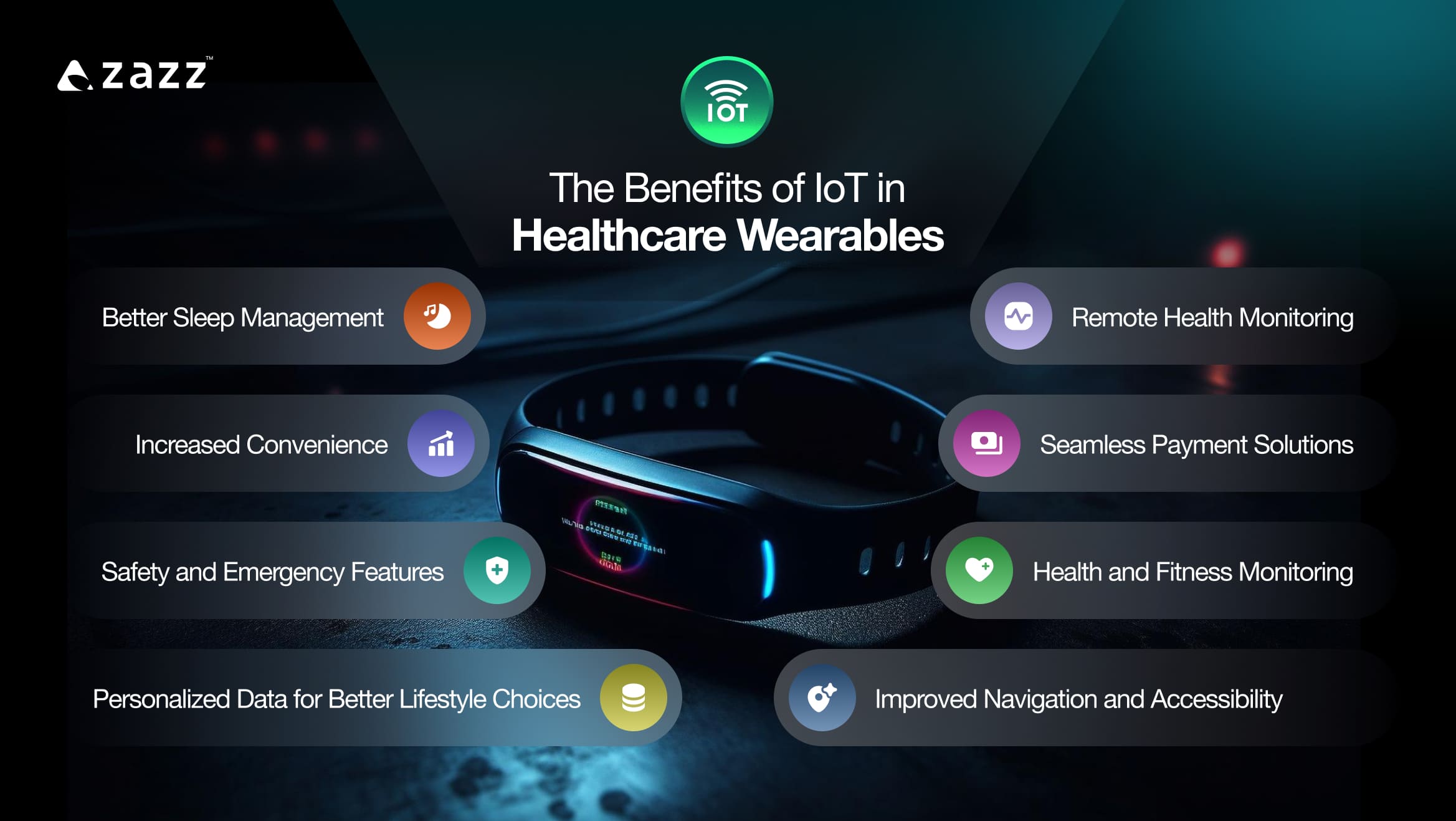
The Internet of Things wearable technology is transforming everyday experiences by integrating advanced technology into our daily lives. Here are some insightful benefits of IoT in wearable devices, presented with examples:
Increased Convenience
Wearable IoT devices offer unprecedented convenience in managing daily tasks. For example, smartwatches allow users to check messages, schedule reminders, and even control home appliances without ever touching their smartphones. This hands-free management streamlines daily activities and makes multitasking easier and more efficient.
Health and Fitness Monitoring
Wearables like fitness bands and smartwatches are equipped with sensors that track physical activity, such as steps taken, calories burned, and heart rate. These devices provide real-time feedback and health insights, enabling users to maintain or adjust their fitness routines effectively. For instance, a fitness band might vibrate to remind you to stand up and move around if you’ve been inactive for too long. This, in turn, helps promote a healthier lifestyle.
Safety and Emergency Features
IoT in wearable devices can enhance personal safety. Some devices come equipped with GPS tracking and emergency response features, which can be life-saving in critical situations. For example, certain smartwatches have fall detection capabilities that automatically alert emergency contacts if the wearer falls and can’t get up.
Improved Navigation and Accessibility
Wearables with IoT capabilities include navigational aids that help users find their way in unfamiliar places. For instance, a smart glove for visually impaired individuals vibrates to indicate directions. This helps them navigate city streets safely and independently.
Remote Health Monitoring
This is particularly beneficial for individuals with chronic conditions or the elderly. Health-monitoring wearables can transmit data directly to healthcare providers, who can monitor patients remotely. This allows patients to receive timely medical attention and reduces the need for frequent hospital visits. For example, a wearable heart monitor can alert a doctor if a patient’s heart rate shows irregular patterns, prompting immediate intervention.
Better Sleep Management
Many Internet of Things wearable technology tracks sleep patterns, providing insights into sleep quality, duration, and sleep cycles. This information can help users and their healthcare providers understand and improve their sleep habits. For example, a wearable sleep tracker can suggest bedtime routines or environmental changes to enhance sleep quality based on the tracked data.
Seamless Payment Solutions
Some wearables now come with integrated payment technology, allowing users to make contactless payments quickly and securely. This is especially convenient in places like gyms or while traveling, where carrying a wallet isn’t always practical.
Personalized Data for Better Lifestyle Choices
By collecting data over time, Internet of Things wearable devices provide personalized insights that can influence lifestyle choices. For instance, if a device notices you’re less active on days you work late, it might suggest short workouts you can do at the office or remind you to get up and stretch regularly.
Related reading: IoT Application Development: A Complete Guide
Key Applications of IoT in Wearables
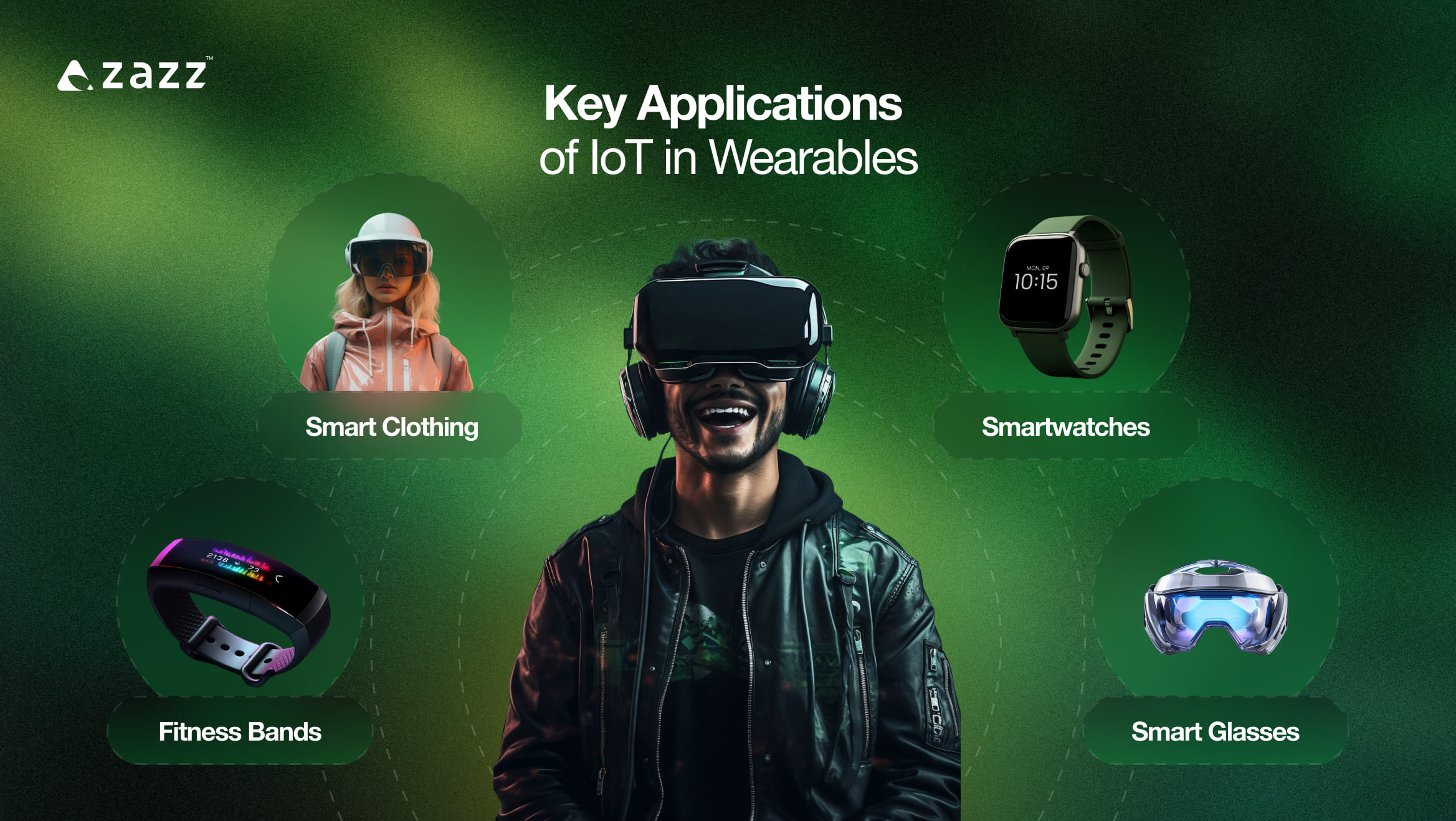
The Internet of Things (IoT) has significantly broadened the scope and functionality of wearable technology. Here are the key application of IoT in wearables:
Smartwatches
Smartwatches, such as the Apple Watch or Samsung Galaxy Watch, are equipped with sensors that track a wide range of health metrics including heart rate, steps taken, and even blood oxygen levels. For example, during a workout, a smartwatch can continuously monitor your heart rate and calories burned, offering insights and feedback to optimize your exercise routine.
These devices keep you connected by displaying notifications for texts, calls, and app alerts right on your wrist. This means you can see important messages or receive calendar reminders without ever needing to pull out your phone.
Smartwatches also come with GPS capabilities, allowing users to navigate without their phones. For instance, while exploring a new city, you can receive turn-by-turn directions directly on your watch. This helps you find your way around without handling multiple devices.
Smart Clothing
Smart clothing is designed with embedded sensors to monitor and improve athletic performance. For instance, smart socks and shoes can analyze your running form, providing feedback on how to adjust your stride to avoid injuries.
Items like smart shirts can measure vital signs such as heart rate and respiratory rate more accurately and less intrusive than some traditional wearables. For example, a smart shirt used during a hospital stay can continuously send vital statistics to the nursing station. This enables better patient monitoring without the constant manual checks.
Smart clothing can also regulate temperature based on external conditions. Jackets with built-in heating elements can adjust the temperature based on how cold it is outside. This provides optimal comfort for the wearer.
Fitness Bands
Fitness bands like the Fitbit are designed to simplify the tracking of physical activity and basic health monitoring. For instance, a Fitbit fitness band can track the number of steps you take each day, calculate the distance you’ve walked, and help you achieve your daily fitness objectives.
These bands also often include sleep tracking technology, which can help users understand their sleep patterns by monitoring movement and heart rate during sleep. This data can be used to improve sleep habits and overall health.
Smart Glasses
Smart glasses like Google Glass or other Augmented Reality(AR) wearables overlay digital information onto the real world. For instance, a mechanic wearing AR glasses could see repair instructions displayed directly on the equipment they are fixing.
They can also provide real-time information based on what the wearer sees, such as translating a menu in a foreign language instantly or giving details about landmarks and buildings viewed during travel.
Related reading: 10 Best IoT Tools to Consider
Common Challenges in Integrating IoT and Wearables
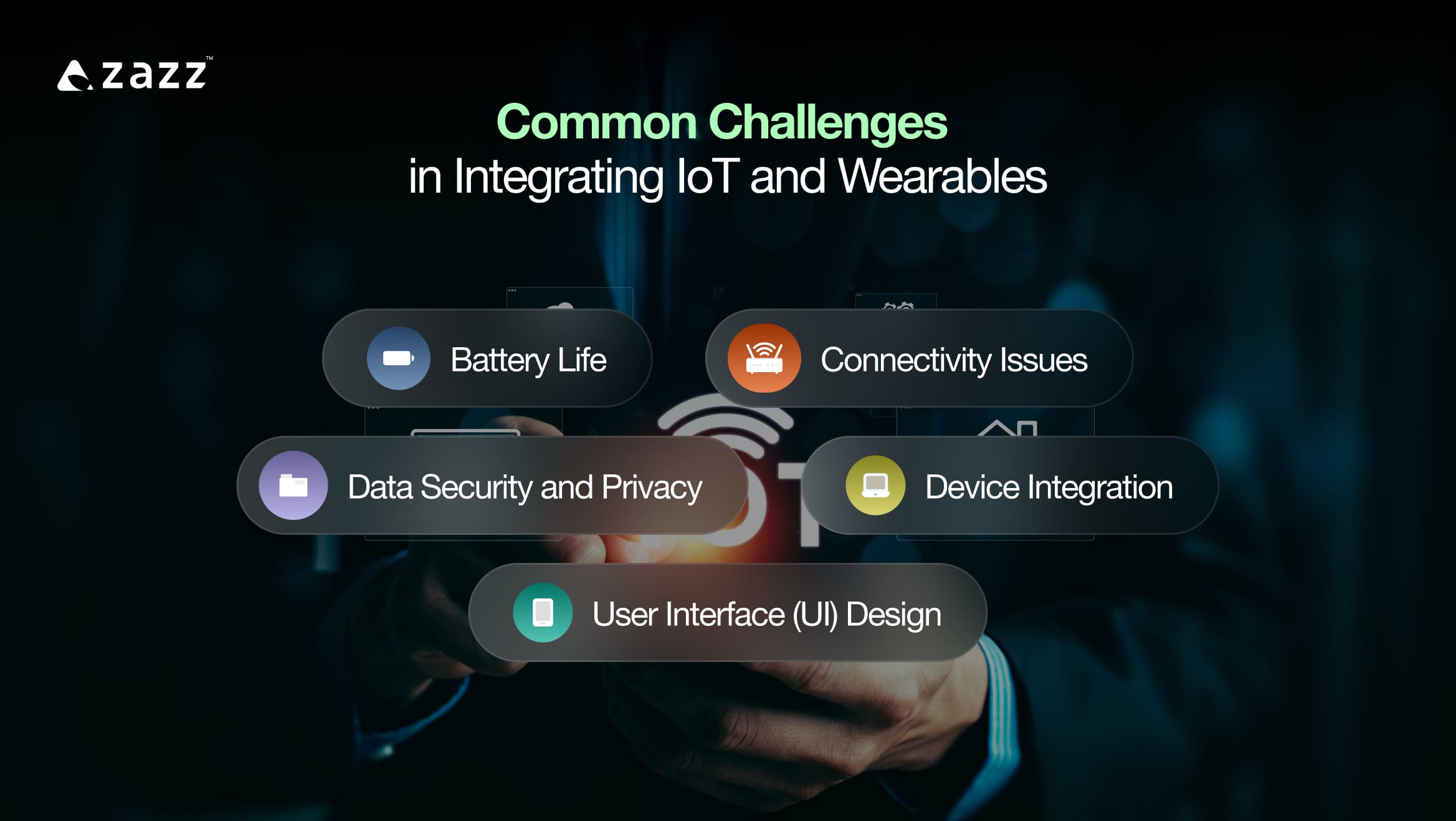
Integrating IoT with wearables presents several challenges that can impact their functionality and user experience. Here are some common issues:
Battery Life
Wearables require efficient power management to extend battery life, as frequent charging can deter users from adopting these devices. For instance, a smartwatch that needs daily charging may not appeal to all users.
Data Security and Privacy
With wearables collecting personal health and activity data, ensuring the security and privacy of this information is crucial. There’s a constant need for strong encryption methods and secure data transfer protocols to protect user data from breaches.
Connectivity Issues
Consistent and reliable connectivity is vital for wearable IoT devices to function correctly. These devices often rely on Bluetooth or Wi-Fi to sync data, and any disruption in connectivity can affect their performance and the accuracy of the data collected.
Device Integration
Making sure that wearables work seamlessly with other devices, such as smartphones or other smart technology in the home, can be challenging. Compatibility issues can hinder the user experience, limiting the device’s usefulness.
User Interface (UI) Design
The small screens of wearables require UI designs that are intuitive and easy to navigate. Creating an interface that allows users to access information and functionalities effortlessly is a significant challenge for developers.
Related reading: Best IoT Programming Languages
IoT Trends in Wearable Sector
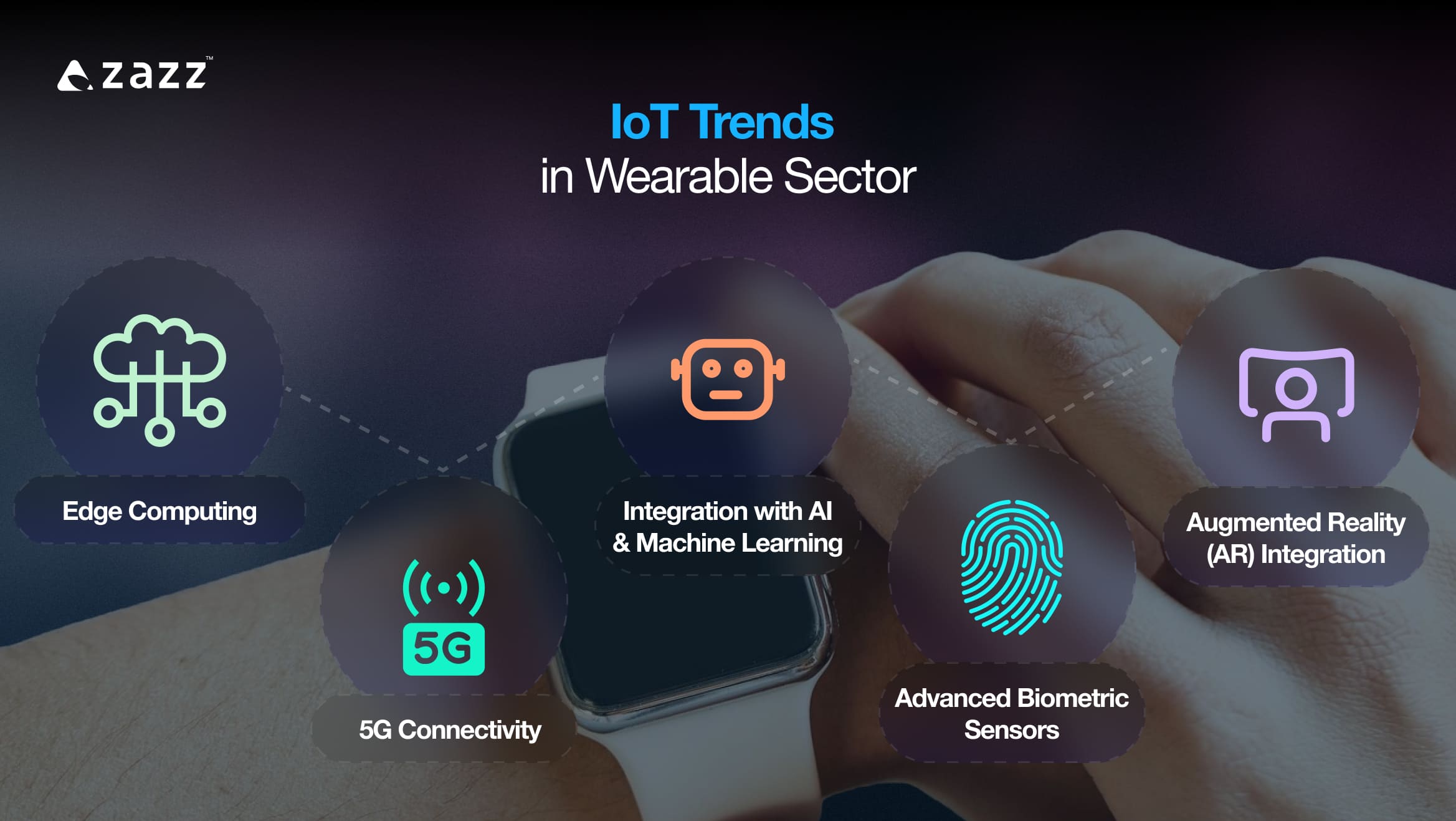
In the domain of IoT wearables, ongoing technological advancements are propelling the industry forward, presenting innovative applications and improving user experiences. Here are some key trends in the application of IoT in wearables:
Advanced Biometric Sensors
The integration of sophisticated biometric sensors in wearables is a significant trend. These sensors can now track a wider array of health metrics, including heart rate variability, blood pressure, and even glucose levels non-invasively. This trend is particularly impactful in healthcare, providing real-time data for continuous health monitoring.
Edge Computing
To address privacy concerns and reduce latency, edge computing is becoming more prevalent in wearables. By processing data directly on the device rather than sending it to the cloud services, wearables can offer faster responses and enhanced data security. This is crucial for applications like real-time health monitoring and emergency response.
Augmented Reality (AR) Integration
AR is being integrated into wearables like smart glasses to provide users with real-time information overlaying their physical environment. This technology enhances navigation, provides educational content, and even aids in complex tasks by offering hands-free instruction.
5G Connectivity
The rollout of 5G technology promises to revolutionize IoT wearables by enabling faster data transfer rates, reduced latency, and increased connection stability. This is essential for wearables that require real-time data syncing and is particularly beneficial for emergency health alerts and fitness tracking.
Integration with AI and Machine Learning
AI and machine learning are being increasingly integrated into wearables to make the data collected more actionable. For example, wearables can now provide personalized recommendations and insights based on the user’s activity patterns and health data.
Flexible and Stretchable Electronics
Advances in materials science have led to the development of flexible and stretchable electronic components that can be embedded into clothing or worn on the skin. This trend is expanding the possibilities for wearables, making them more comfortable and less obtrusive, and allowing for a wider range of applications, from fitness tracking to advanced health monitoring systems.
Energy Harvesting Technologies
To combat the challenge of limited battery life, newer wearables are incorporating energy harvesting techniques that generate power from the wearer’s body movements or heat. This innovation aims to extend battery life and reduce the need for frequent recharges.
The Future of IoT Technology in Wearables
The future of IoT in wearables is set to expand significantly, especially in areas like fitness and health tracking. The wearable technology market is projected to grow from USD 199.73 billion in 2024 to over USD 2.34 trillion by 2037, showing a compound annual growth rate (CAGR) of over 20.6% from 2025 to 2037.
This growth is driven by consumers’ increasing interest in personal health and fitness monitoring, using devices that provide real-time data on their activities and health stats. IoT wearables are becoming more popular not just among health enthusiasts but also in everyday settings to enhance lifestyle and productivity.
At Zazz, we are actively developing solutions that tap into this trend, providing advanced IoT services that help businesses across various industries integrate wearable technologies. Our expert team focuses on creating user-friendly, efficient devices that cater to the diverse needs of our clients. This helps them leverage the dynamic expansion of the wearable market.
Related reading: IoT in Healthcare Indstry
Summing Up!
In this insightful exploration of IoT in wearables, we’ve uncovered the transformative impact these technologies are having on everyday life, from enhancing personal health to revolutionizing how we interact with the world around us. As we look to the future, the wearable tech market is poised for explosive growth, promising to bring even more innovative solutions into our daily routines.
At Zazz, we lead the way in this dynamic industry, creating advanced solutions that integrate smoothly across different sectors, improving both personal and professional experiences. Our dedication to innovation guarantees that our clients receive top-tier IoT wearable technologies.
For more information or to explore how IoT wearable technology can benefit your operations, reach out to Zazz today!
Frequently Asked Questions
IoT wearables are devices like smartwatches and fitness bands that are connected to the internet, allowing them to send and receive data to enhance functionality and user interaction.
IoT wearables can track a wide range of health metrics, such as heart rate, sleep patterns, and physical activity, providing real-time data to users and healthcare providers to better monitor and manage health.
Common challenges include maintaining battery life, ensuring data security and privacy, achieving reliable connectivity, and integrating with other devices.
Zazz specializes in developing IoT wearable solutions that cater to the specific needs of different industries, focusing on user-friendly and efficient technologies that enhance both functionality and user experience.
IoT wearable devices today range widely, including fitness bands, smartwatches, health monitors, and even smart clothing.
Recent Articles
Table of Content 1. Data Engineer vs. Data Scientist: Understanding...
Table of Content 1. What is the Carnival in Brazil?...
Table of Content 1. What is IT Staff Augmentation? 2....












